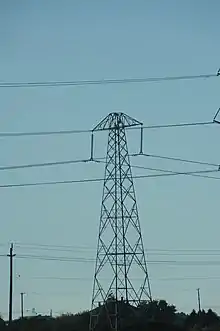HVDC Vancouver Island
HVDC Vancouver Island is a high-voltage direct current interconnection between the Vancouver Island Terminal (VIT) in North Cowichan, British Columbia on Vancouver Island at 48°49′39″N 123°42′55″W and the Arnott Substation (ARN) in Delta, British Columbia at 49°5′31″N 123°2′31″W on the Canadian mainland. It went into operation in 1968 and was extended in 1977. HVDC Vancouver Island consists of three overhead line sections with a total length of 42 kilometres and two submarine cable sections with a length of 33 kilometres.
| HVDC Vancouver Island | |
|---|---|
 HVDC Vancouver Island pylon | |
| Location | |
| Country | Canada |
| State | British Columbia |
| Coordinates | 48°49′39″N 123°42′55″W |
| From | North Cowichan, British Columbia |
| To | Delta, British Columbia |
| Ownership information | |
| Owner | BC Hydro |
| Operator | BC Hydro |
| Construction information | |
| Installer of substations | ASEA |
| Commissioned | Pole 1: 1968 Pole 2: 1977 |
| Decommissioned | Pole 1: 2016 |
| Technical information | |
| Type | Multi-terminal |
| Type of current | HVDC |
| Total length | 75 km (47 mi) |
| Power rating | 370 MW |
| DC voltage | 280 kV |
Route
After its departure from Arnott Substation the overhead power line on the mainland splits at 49°3′38″N 123°4′30″W into two branches, one running to a terminal at 49°3′6″N 123°7′22″W and the other running to a terminal at 49°1′40″N 123°6′1″W, where the first submarine cable section begins.
At 48°55′07″N 123°24′15″W, the first submarine cable section ends and a short overhead line section running south-west across Galiano Island starts. The overhead line leaves Galiano Island south of Montague Harbour in an 880-metre-long span, which starts at 48°52′51″N 123°23′21″W and ends on Parker Island at 48°52′48″N 123°24′04″W.
A little to the west, on Parker Island at 48°52′45″N 123°24′9″W the overhead line ends and the second submarine cable section begins. At 48°51′2″N 123°25′31″W the cable reaches Salt Spring Island and the third overhead line section starts. It crosses Salt Spring Island west-south-westerly. North of Maxwell Point at 48°49′54″N 123°33′50″W and Arbutus Point at 48°49′40″N 123°35′21″W the overhead line crosses Sansum Narrows, the strait between Salt Spring Island and Vancouver Island, by a 1900-metre-long span. After this span the overhead line runs westward to Vancouver Island Terminal near the town of Duncan.
History
In 1968 the first pole of the HVDC Vancouver Island link went into service. Its static inverters use mercury vapour rectifiers. Each of these rectifiers is 3.35 metres (11 ft) long, 1.22 metres (4 ft) wide and 6.10 metres (20 ft) high and has a weight of 4.5 metric tons. The valves are situated in a hall 26.21 metres (86 ft) long, 11.89 metres (39 ft) wide and 11.28 metres (37 ft) high. The maximum transmission capacity of this pole is 312 megawatts and the transmission voltage is 260 kV. The stations Vancouver Island Terminal and Arnott Substation were designed and delivered by Swedish company ASEA (later ABB). The Swedish team of some 10 people were headed for the first phase by Ivan Hedlund and for the second phase by Gunnar Ahgren.
In 1977 the HVDC Vancouver Island link was supplemented by installing a second pole. This pole uses thyristor valves for its static inverters and operates at a voltage of 280 kV with a rating of 370 megawatts. A new 230 kV. submarine cable for three-phase alternating current has been constructed between the Canadian mainland and Vancouver Island. This parallels the existing two HVDC lines and replaces one of two earlier 138 kV lines. The HVDC systems are at the end of their service life and are not considered to be reliable. As a result of this, the first pole was shut down in 2016.
Electrodes and metallic return
HVDC Vancouver Island uses metallic return, during monopolar operation, when current is lower than 600 A. Otherwise earth return is used. On Vancouver Island the line for metallic return is a monopolar line on wooden poles, which are used in some sections also by AC lines, running parallel to the main line of HVDC Vancouver Island.
On the mainland, it uses the poles of the electrode line until a point at 49°3′39″N 123°2′34″W. After this point it runs on wooden poles together with a single-circuit three-phase AC line until 49°2′25″N 123°4′32″W. From there it runs as underground cable to Splasdown Park, where it transits at 49°1′58″N 123°5′26″W again into an overhead line, which ends at the terminal of the main line at 49°1′40″N 123°6′1″W.
The electrode on the Canadian Mainland is a land electrode situated at Boundary Bay at 49°03′25″N 123°01′46″W. It is connected with Arnott Substation by an overhead pole line with two conductors. The electrode on Vancouver Island is a shore electrode in a bay at Sansum Narrows at 48°46′22″N 123°34′24″W. It is connected with Vancouver Island Terminal by an overhead line with two conductors, which is installed on wooden poles. It runs between Vancouver Island Terminal and a point northwest of Maple Bay at 48°49′35″N 123°37′38″W parallel to other power lines.
See also
External links
- http://www.bctransco.com/regulatory/applications/Vancouver+Island+Transmission+Reinforcement+Project+CPCN+Application.htm
- https://web.archive.org/web/20051115122606/http://www.transmission.bpa.gov/cigresc14/Compendium/VANCOU.htm
- https://web.archive.org/web/20051115122606/http://www.transmission.bpa.gov/cigresc14/Compendium/Vancou+Pictures.pdf
- https://www.openstreetmap.org/relation/6026488#map=10/48.9396/-123.2391